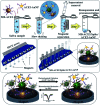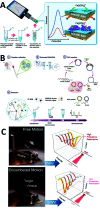The role of electrochemical biosensors in SARS-CoV-2 detection: a bibliometrics-based analysis and review
- PMID: 36105989
- PMCID: PMC9372877
- DOI: 10.1039/d2ra04162f
The role of electrochemical biosensors in SARS-CoV-2 detection: a bibliometrics-based analysis and review
Erratum in
-
Correction: The role of electrochemical biosensors in SARS-CoV-2 detection: a bibliometrics-based analysis and review.RSC Adv. 2022 Nov 2;12(48):31441. doi: 10.1039/d2ra90107b. eCollection 2022 Oct 27. RSC Adv. 2022. PMID: 36349049 Free PMC article.
Abstract
The global pandemic of COVID-19, which began in late 2019, has resulted in extremely high morbidity and severe mortality worldwide, with important implications for human health, international trade, and national politics. Severe acute respiratory syndrome coronavirus (SARS-CoV-2) is the primary pathogen causing COVID-19. Analytical chemistry played an important role in this global epidemic event, and detection of SARS-CoV-2 even became a part of daily life. Analytical chemists have devoted much effort and enthusiasm to this event, and different analytical techniques have shown very rapid development. Electrochemical biosensors are highly efficient, sensitive, and cost-effective and have been used to detect many highly pathogenic viruses long before this event. However, another fact is that electrochemical biosensors are not the technology of choice for most detection applications. This review describes for the first time the role played by electrochemical biosensors in SARS-CoV-2 detection from a bibliometric perspective. This paper analyzed 254 relevant research papers up to June 2022. The contributions of different countries and institutions to this topic were analyzed. Keyword analysis was used to explore different methodological attempts of electrochemical detection techniques. More importantly, we are trying to find an answer to the question: do electrochemical biosensors have the potential to become a genuinely employable detection technology in an outbreak of infectious disease?
This journal is © The Royal Society of Chemistry.
Conflict of interest statement
There are no conflicts to declare.
Figures








Similar articles
-
[Applications of separation technology in novel coronavirus research, epidemic prevention and detection].Se Pu. 2021 Jul 8;39(7):679-685. doi: 10.3724/SP.J.1123.2021.03022. Se Pu. 2021. PMID: 34227364 Free PMC article. Review. Chinese.
-
Recent Developments in Electrochemical-Impedimetric Biosensors for Virus Detection.Int J Mol Sci. 2022 Dec 14;23(24):15922. doi: 10.3390/ijms232415922. Int J Mol Sci. 2022. PMID: 36555560 Free PMC article. Review.
-
Utilizing Electrochemical-Based Sensing Approaches for the Detection of SARS-CoV-2 in Clinical Samples: A Review.Biosensors (Basel). 2022 Jun 29;12(7):473. doi: 10.3390/bios12070473. Biosensors (Basel). 2022. PMID: 35884276 Free PMC article. Review.
-
Recent Progresses in Electrochemical DNA Biosensors for SARS-CoV-2 Detection.Front Bioeng Biotechnol. 2022 Jul 15;10:952510. doi: 10.3389/fbioe.2022.952510. eCollection 2022. Front Bioeng Biotechnol. 2022. PMID: 35910031 Free PMC article. Review.
-
Electrochemical Biosensors for the Detection of SARS-CoV-2 and Other Viruses.Micromachines (Basel). 2021 Feb 10;12(2):174. doi: 10.3390/mi12020174. Micromachines (Basel). 2021. PMID: 33578979 Free PMC article. Review.
Cited by
-
Faradaic Impedimetric Immunosensor for Label-Free Point-of-Care Detection of COVID-19 Antibodies Using Gold-Interdigitated Electrode Array.Biosensors (Basel). 2023 Dec 22;14(1):6. doi: 10.3390/bios14010006. Biosensors (Basel). 2023. PMID: 38248383 Free PMC article.
-
Hotspots and trends of electrochemical biosensor technology: a bibliometric analysis from 2003 to 2023.RSC Adv. 2023 Oct 19;13(44):30704-30717. doi: 10.1039/d3ra05889a. eCollection 2023 Oct 18. RSC Adv. 2023. PMID: 37869385 Free PMC article. Review.
-
Protein Stacking on the APTES-Functionalized Pyrochlore Bi2Ru2O7 Clusters for Ultrasensitive and Selective Immunosensing.ACS Appl Mater Interfaces. 2025 Feb 19;17(7):10792-10801. doi: 10.1021/acsami.4c17869. Epub 2025 Feb 6. ACS Appl Mater Interfaces. 2025. PMID: 39911050 Free PMC article.
-
Strategies in the optimization of DNA hybridization conditions and its role in electrochemical detection of dengue virus (DENV) using response surface methodology (RSM).RSC Adv. 2023 Jun 16;13(27):18748-18759. doi: 10.1039/d3ra00216k. eCollection 2023 Jun 15. RSC Adv. 2023. PMID: 37362605 Free PMC article.
-
Marketing Strategies in Nanomaterials for Sensor Applications: Bridging Lab to Market.Glob Chall. 2025 Mar 17;9(5):2400294. doi: 10.1002/gch2.202400294. eCollection 2025 May. Glob Chall. 2025. PMID: 40352637 Free PMC article. Review.
References
Publication types
LinkOut - more resources
Full Text Sources
Miscellaneous

